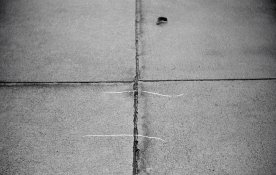Here we have a bit of a frame (Fomapan 200 135/36) showing myriad tiny scratches in the emulsion layer, all at very similar angles; these are visible quite uniformly over the full length of the roll , over the full width of the roll, and all at the same similar angles. The developed leader has these too, but the undeveloped leader is long gone, so I can't examine that.
The film was loaded into and developed in a Paterson tank on a Paterson reel, in APH09 (Rodinal) and fixed in Ilford rapid fix.
I've developed many rolls from the same batch of Fomapan, without seeing anything remotely similar, so I can't imagine it's a manufacturing problem; Never seen it on any other negatives either, come to that, so I'm assuming it must be something particular to the processing of this roll. I can't conceive how scratches like this - across the width of the film - could come about from a physical cause within camera, or from loading onto the reel.
It's as if there was some quite abrasive material suspended in either developer or fixer that has abraded the emulsion layer during agitation. So perhaps something nasty came out of the tap that night ...
any other hypotheses to account for it?
The film was loaded into and developed in a Paterson tank on a Paterson reel, in APH09 (Rodinal) and fixed in Ilford rapid fix.
I've developed many rolls from the same batch of Fomapan, without seeing anything remotely similar, so I can't imagine it's a manufacturing problem; Never seen it on any other negatives either, come to that, so I'm assuming it must be something particular to the processing of this roll. I can't conceive how scratches like this - across the width of the film - could come about from a physical cause within camera, or from loading onto the reel.
It's as if there was some quite abrasive material suspended in either developer or fixer that has abraded the emulsion layer during agitation. So perhaps something nasty came out of the tap that night ...
any other hypotheses to account for it?















